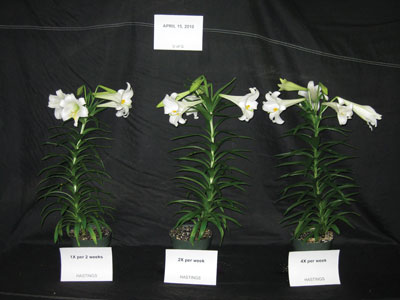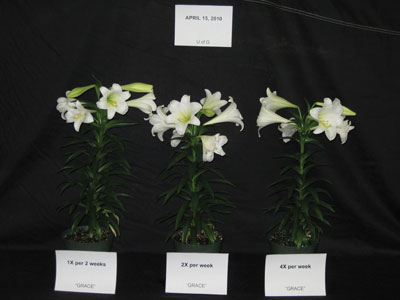
Features
Fertilizer
Inputs
Irrigation and Easter lilies
January 28, 2011 By Dr. Theo J. Blom and David Kerec University of Guelph Ontario
Easter lilies are usually watered on demand using either overhead or subirrigation.
Easter lilies are usually watered on demand using either overhead or subirrigation. During the winter months, when plants are small and evapo-transpiration is low, the irrigation strategy may be questioned. One of the common questions is whether to water small amounts often or large amounts less frequently.
 |
|
| Plants received the same irrigation volume over each two-week period from planting to flowering (~17 weeks). Advertisement
|
With this question in mind, we started an experiment during the fall of 2009 to determine whether there is an effect from irrigation frequency.
MATERIALS AND METHODS
■ Bulbs of two suppliers of ‘Nellie White’ and sized 8/9 in circumference were planted in SunGro #4 using 15-cm diameter standard plastic pots on Dec. 2, 2009. Bulb weights were 148 g and 126 g for the two suppliers, respectively. A new cultivar (‘Grace’) was also included.
Plants were placed on open-mesh benches at a spacing of 30 / m2.
Irrigation frequency was based on three different ways: (i) once / two weeks; (ii) twice / week; and (iii) four times / week.
 |
|
| Fig. 1 – The effect of irrigation frequency on Easter lilies ‘Nellie White’ and ‘Grace’ (source: Hastings Inc., Oregon). PHOTOS COURTESY DR. THEO BLOM, U OF GUELPH |
All plants were initially irrigated with a total of 400 mL over a period of two weeks using 375 ppm of N from 15-0-15. The plants that were irrigated once in two weeks were provided with a small tray in order to handle the extra solution.
On March 8, the irrigation volume was increased to 500 mL over a period of two weeks. The volumes of the individual waterings were adjusted accordingly. There were two blocks (=benches) with each block having three irrigation frequencies by two suppliers and with each experimental unit containing 18 plants.
Irrigation was overhead by pouring the irrigation solution directly onto the soil surface using a graduated cylinder. No plant growth retardants were applied. All plants were grown at a temperature of 16°C D/N with no DIF until the middle of February after which it was changed to 20/20°C.
At flowering, the following measurements were taken: date of flowering; plant height from top of pot to the base of the inflorescence as well as to the highest point of the inflorescence; and number of primary, secondary, tertiary and aborted buds, as well as the number of yellow leaves.
 |
|
| Table 1. The effects of irrigation frequency on flowering date, plant height, number of healthy and aborted buds, as well as yellow and total number of leaves of Easter lily ‘Nellie White.’ Data represent the mean of 56 plants. |
Results are summarized in Table 1. As there was no effect from the bulb supplier, the data is presented as the mean for the two suppliers. The effect of irrigation frequency did not have an effect on plant height (Fig. 1) or on the number of buds. The number of yellow leaves in the lowest frequency treatment may be due to occasional over-saturation of the substrate. This experiment will be repeated in 2011.
Print this page